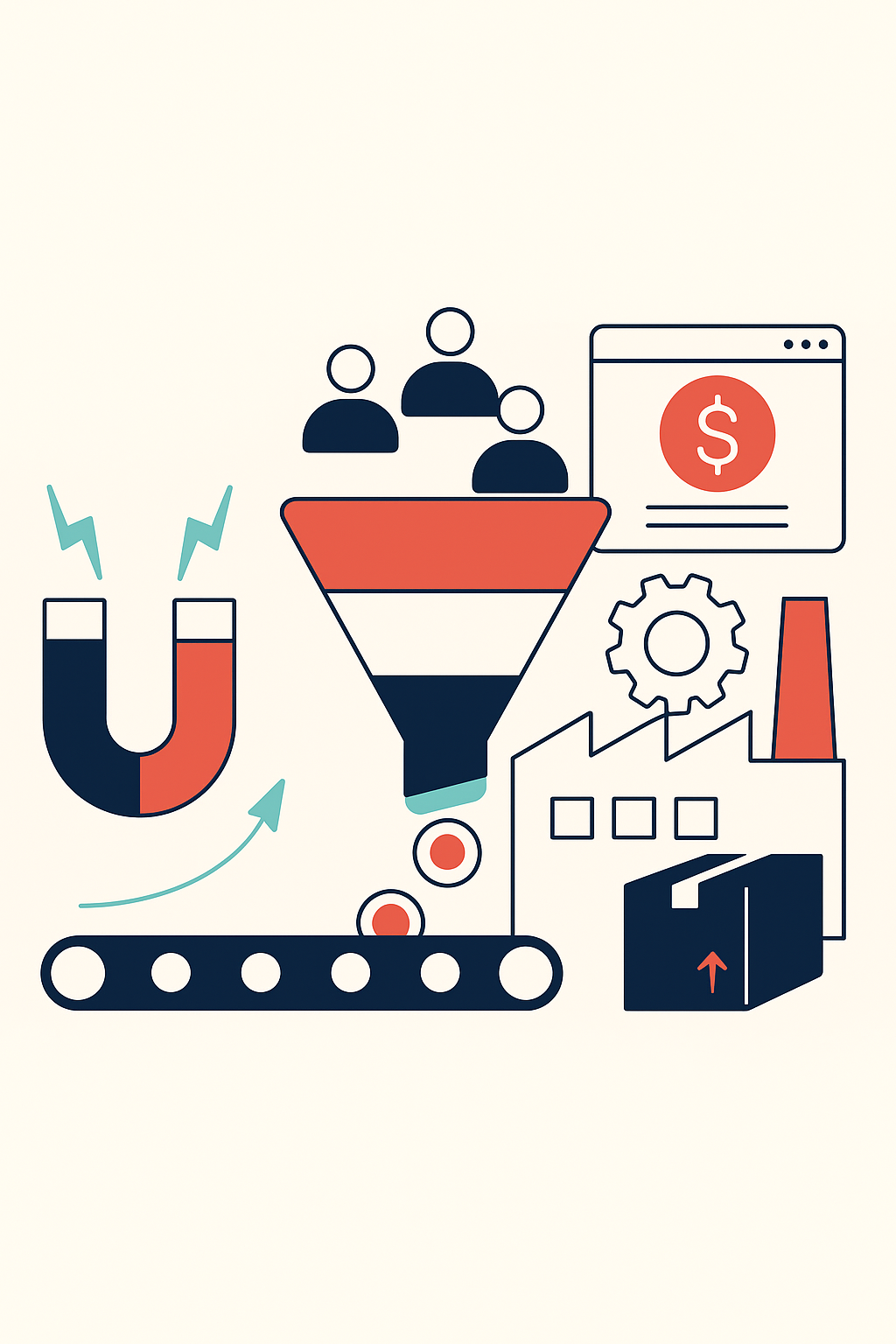How To Qualify Leads In Manufacturing Sales
Manufacturing sales isn’t just about driving demand—it’s about focusing that demand in the right direction. If you’re selling across multiple states, qualifying leads becomes even more critical. Each region brings its own operational quirks, buying behaviors, and decision-making structures. Without a consistent, thoughtful qualification process, your sales team spends hours chasing prospects who will never buy, can’t buy, or aren’t worth closing.
In this guide, we’re breaking down how to qualify leads in manufacturing sales, step by step. Whether you’re the VP of Sales overseeing multiple territories or a sales manager focused on building a tighter pipeline, this framework will help you zero in on your best-fit opportunities and maximize your close rate.
Why Lead Qualification Is Essential in Manufacturing Sales
If you’ve worked in manufacturing sales, you already know how expensive it is to chase the wrong lead. Long sales cycles, large technical investments, and highly specific needs mean that one poor-fit prospect can waste months of your team’s time. Multiply that by several territories, and the opportunity cost starts to balloon.
The stakes are higher in multi-state sales environments. Buying committees vary from region to region, procurement processes differ, and even regulatory requirements can impact whether or not you’re a viable solution. For manufacturers, proper qualification is the difference between building a clean, scalable pipeline or burning out your sales team with constant dead ends.
A strong qualification process saves time, reduces friction between sales and marketing, and gives you the confidence to invest resources into deals that are actually winnable.
Step 1: Know Exactly Who You’re Targeting
Before qualifying a lead, you need a crystal-clear picture of your ideal customer profile (ICP). This isn’t just about industry or company size. For manufacturing, it means understanding operational complexity, facility distribution, production capabilities, and supply chain priorities.
Let’s say your company manufactures automation components for food and beverage processors. An ideal customer might be a multi-facility operation with at least $50M in annual revenue, located within your service radius, and actively investing in process improvement initiatives. These are the kinds of factors that define a high-fit customer, not just someone who clicked a link in your last email campaign.
Your ICP should include both company-level attributes and behavioral indicators that suggest a genuine need. The more specific you are, the easier it becomes to separate high-potential leads from the rest of the list.
Step 2: Get Sales and Marketing on the Same Page
One of the biggest pitfalls we see in manufacturing organizations is the disconnect between the teams that generate leads and the teams that work them. Marketing might define a qualified lead as filling out a contact form. But to your sales reps, that person may have no real budget, no decision-making authority, and no intent to buy.
The solution? A shared definition of what makes a lead qualified.
Sales and marketing must agree on what counts as a Marketing Qualified Lead (MQL) versus a Sales Qualified Lead (SQL). That means sitting down together and mapping out exactly what a lead must look like before it gets passed to sales. Are you requiring a confirmed budget? Do they need to meet specific facility size thresholds? What behavioral signals matter?
When your qualification criteria are built collaboratively and documented clearly, both teams work more efficiently. Salespeople can trust the leads they receive. Marketing can refine campaigns around what actually converts. And your close rates go up.
Step 3: Use the Right Qualification Framework (And Customize It for Manufacturing)
There are plenty of lead qualification models out there, but the classic BANT framework—Budget, Authority, Need, Timeline—is still a great place to start.
That said, manufacturers often need a more tailored version. A plant manager might have influence, but not final authority. Budgets may be set annually or tied to project-specific capital expenditures. And “need” can vary widely depending on operational goals, compliance requirements, or shifts in demand forecasting.
Here’s how you might adapt BANT for a real-world qualification call:
You’re speaking to a maintenance supervisor at a plastics manufacturer in Ohio. They’re exploring automation upgrades but haven’t fully scoped the project. During the conversation, you ask if the budget has been allocated for automation this year. They confirm $200K has been approved for equipment upgrades, and they’re comparing vendors now. You ask who’s involved in the final decision, and it turns out it’s the Director of Engineering and the CFO. You learn they’re seeing too much downtime with their current setup and need implementation before Q4 to meet a large client’s order volume.
That’s a fully qualified lead. You’ve confirmed budget, identified the right stakeholders, uncovered a pressing operational need, and validated an urgent timeline. More importantly, you’ve done it through conversation, not a checklist.
Step 4: Score Leads to Prioritize Your Pipeline
Not every lead is black or white. Some will be perfect fits. Others will be on the fence. That’s where lead scoring comes in.
By assigning values to specific criteria—company size, decision-maker title, project urgency, facility count—you can create a weighted system that helps your team prioritize outreach. A lead with an operations manager in a $100M company who downloaded your product brochure and requested a site visit will naturally outrank someone who simply opened an email.
Lead scoring doesn’t have to be overly complex. What matters is that it reflects the real-world factors that drive deals in your space. For manufacturing, that usually includes facility size, production complexity, budget visibility, and timeline clarity.
With a scoring model in place, your reps aren’t left guessing who to call first. And your CRM can flag high-scoring leads in real time, triggering faster and more informed outreach.
Step 5: Adjust Your Approach by Region
If you’re selling into multiple states, you already know that what works in Illinois may not work in Arizona. Regional nuance is everything in manufacturing sales.
Some states may have stricter regulatory environments. Others may favor local vendors or require different types of certifications. Labor challenges, freight logistics, and supply chain infrastructure also vary widely by geography.
That means your qualification process should account for regional differences. A plant manager in California may ask more about sustainability and emissions. One in Georgia might care more about labor-saving automation. Your qualification questions—and your sales messaging—should flex accordingly.
The best way to do this is to train your team to recognize these patterns. Track win rates by region, identify common objections or delays, and adjust your outreach strategy based on what you learn. Over time, you’ll build a qualification playbook that’s not just accurate—it’s regionally optimized.
Step 6: Equip Your Team With the Right Tools
A good process is only as strong as the tools that support it. In manufacturing sales, your tech stack should help your reps move faster, qualify smarter, and keep the pipeline clean.
At minimum, your CRM should capture every lead interaction and make it easy to flag qualification details. Email automation platforms can help marketing nurture colder leads while your reps focus on the ones that are truly sales-ready. Data enrichment tools can pull in firmographic and operational insights—things like facility locations, recent investments, or leadership changes—that help determine fit even before the first call.
Better still, partner with a sales enablement team that can do this for you.
Sapper’s outbound programs are built to deliver fully qualified sales appointments, not just raw contact lists. We combine outbound messaging, intent data, and lead nurturing to surface the right opportunities across your territories—so your team can spend more time selling and less time sorting.
Step 7: Continuously Improve Your Qualification Process
Your qualification criteria shouldn’t be static. Markets shift, and buyer behavior evolves. What worked last quarter may not apply today.
Maybe your team is seeing lower conversion rates in the Southeast. Or maybe leads with longer sales cycles are quietly outperforming your short-term deals. These are all signals that your process needs to evolve.
Schedule quarterly reviews of your qualification performance. Talk to your sales reps. What do they see in conversations that don’t align with your lead scoring model? What objections keep coming up? Where are deals stalling?
Use this feedback to refine your definitions, adjust your scoring, and update your regional targeting. Qualification is never perfect, but it should always be getting better.
Wrapping Up: Qualification Is Your First Competitive Advantage
Here’s the bottom line: In manufacturing sales, the difference between winning and spinning your wheels usually starts with how well you qualify leads.
A random form submission isn’t enough. You need a consistent, regionally-aware process that filters out the noise and puts the right opportunities in front of your team. And if you’re selling across multiple states, that consistency is non-negotiable.
When you define your ICP, align sales and marketing, use a proven framework like BANT, and leverage tools to streamline the process, you create a qualification engine that fuels predictable growth. And when you work with a partner like Sapper, that engine runs even faster.
If you’re ready to stop guessing which leads are worth your time and start building a more efficient, high-converting sales pipeline, let’s talk. At Sapper, we help manufacturers find, qualify, and convert leads that close.










